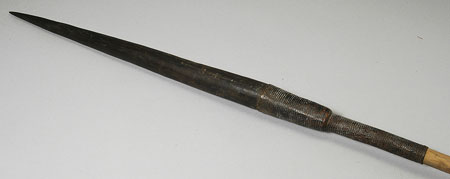Accession Number:
1919.13.18
Country:
Sudan
Region:
[Southern Sudan]
Cultural Group:
Shilluk
Date Made:
By 1919
Materials:
Wood Plant , Antelope Horn Animal , Animal Hide Skin
Process:
Carved , Polished , Covered , Tooled , Decorated Impressed
Dimensions:
Total L = 2227; upper shaft diam = 22 x 21; visible part of spear-head L = 458, base diam = 40 x 38; sheath L = 223, upper diam = 42 x 40 mm [RTS 5/8/2005].
Weight:
637.6 g
Other Owners:
Bought by Louis Colville Gray Clarke at Stevens Auction Rooms on 11th March 1919 (lot 361) and donated to the Pitt Rivers Museum the same year [RTS 5/8/2005].
PRM Source:
Louis Colville Gray Clarke
Acquired:
Donated 1919
Collected Date:
By 1919
Description:
Spear consisting of a narrow, straight point made from dark brown antelope horn with very little ridging and an oval section (Pantone 440C).
The base of this rests against the top of a long narrow shaft of yellowish brown wood (Pantone 7509C), also slightly oval in section, cut from a branch with the outer bark removed.
This has a slightly irregular form, with a few knots running down its length and a slight curvature; it has been shaved to a point at the butt.
Both point and haft have been polished, and the junction between them covered with a dark brown cylindrical sheath (Pantone 440C), cut from a section of animal's tail with the hair removed.
This was stretched over the body whilst wet and then shrunken in place, with the surface tooled
all over, leaving a series of lentoid-shaped impressions in horizontal rows around the circumference.
This decoration has been rubbed smooth in a few places through use.
The spear is complete and intact, with a weight of 637.6 grams.
It has a total length of 2227 mm, with an upper shaft diameter of 22 by 21 mm; the point measures 458 mm from its tip to the top of the sheath, and has a diameter of 40 by 38 mm; the sheath below is 223 mm long with an upper diameter of 42 by 40 mm.
Bought by Louis Colville Gray Clarke at Stevens Auction Rooms on 11th March 1919 (lot 361) and donated to the Pitt Rivers Museum the same year. It was said to be a Shilluk object from the White Nile; the original collector is unknown. Throughout the twentieth century the term ‘White Nile’ has been used to denote an administrative district immediately south of Khartoum. However at the time this object was collected, the term was also used more loosely to refer to the Bahr el Abiad and Bahr el Jebel rivers, or the areas immediately around them. It is not clear in which sense it is being used here, although association with the Shilluk might indicate the river is being referred to rather than the administrative district.
For other Shilluk spears with horn points, see 1919.13.17 and 1929.58.1. Spears tipped with straight, or straightened animal horn are also used by the Nuer (see 1931.66.9 and 1936.10.1), Dinka (1913.15.5) and Mandari (1973.16.2), usually using materials such as antelope or onyx. The Nuer hafted these points as follows: 'The giit ... is fixed at the joint with an unsewn leather collar made from the tail skin of an ox. This is soaked and stretched round the haft, where it shrinks as it dries' (P.P. Howell, 1947, "On the Value of Iron Among the Nuer", Man 47, p. 132-3).
Rachael Sparks 5/8/2005.
Bought by Louis Colville Gray Clarke at Stevens Auction Rooms on 11th March 1919 (lot 361) and donated to the Pitt Rivers Museum the same year. It was said to be a Shilluk object from the White Nile; the original collector is unknown. Throughout the twentieth century the term ‘White Nile’ has been used to denote an administrative district immediately south of Khartoum. However at the time this object was collected, the term was also used more loosely to refer to the Bahr el Abiad and Bahr el Jebel rivers, or the areas immediately around them. It is not clear in which sense it is being used here, although association with the Shilluk might indicate the river is being referred to rather than the administrative district.
For other Shilluk spears with horn points, see 1919.13.17 and 1929.58.1. Spears tipped with straight, or straightened animal horn are also used by the Nuer (see 1931.66.9 and 1936.10.1), Dinka (1913.15.5) and Mandari (1973.16.2), usually using materials such as antelope or onyx. The Nuer hafted these points as follows: 'The giit ... is fixed at the joint with an unsewn leather collar made from the tail skin of an ox. This is soaked and stretched round the haft, where it shrinks as it dries' (P.P. Howell, 1947, "On the Value of Iron Among the Nuer", Man 47, p. 132-3).
Rachael Sparks 5/8/2005.
Primary Documentation:
Accession Book Entry
[VI, p.
119] - 1919 [pencil insert] 13 [end insert]
LOUIS C.G.
CLARKE
Mar[ch].
[pencil insert, p.
120] 17-18 [end insert] [pencil insert] B[ough]t at Stevens 11 March 1919 lot 361 [end insert] - [1 of] 2 wooden spears with straightened antelope horns as points, said to be SHILLUK, WHITE NILE.
Card Catalogue Entry - There is no further information on the tribes catalogue card [RTS 23/7/2004].
Pitt Rivers Museum label - AFRICA, SUDAN. Shilluk tribe? Wooden spear with horn point. Don. L.C.G. Clarke 1919, 1919.13.18 [plastic coated label, tied to object; RTS 5/8/2005].
Written on object - SHILLUK spear with antelope-horn point. WHITE NILE. Pres. by L.C.G. Clarke, 1919 [RTS 25/7/2005].
Card Catalogue Entry - There is no further information on the tribes catalogue card [RTS 23/7/2004].
Pitt Rivers Museum label - AFRICA, SUDAN. Shilluk tribe? Wooden spear with horn point. Don. L.C.G. Clarke 1919, 1919.13.18 [plastic coated label, tied to object; RTS 5/8/2005].
Written on object - SHILLUK spear with antelope-horn point. WHITE NILE. Pres. by L.C.G. Clarke, 1919 [RTS 25/7/2005].



